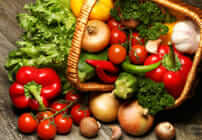The Paleo Diet: What Is It? by Jo Brielyn
The premise of the Paleo Diet is based around common foods that mimic the food groups eaten by our pre-agricultural, hunter-gatherer ancestors. Also sometimes referred to as the Caveman Diet, Paleolithic Nutrition, the Primal Plan, or the Stone Age Diet, the Paleo Diet focuses on only consuming the types of food like meat, fish, eggs, nuts, vegetables, fruits, and roots that would have been hunted, fished, or gathered during the Paleolithic era. The foundation of The Paleo Diet is meat, seafood, and an unlimited amount of fresh fruits and veggies. The plan encourages the replacement of dairy and grain products with lots of fresh fruits and vegetables. So, basically, if the cavemen didn’t eat it, neither will you on this eating plan!
Here is a quick rundown of what The Paleo Diet website advises to eat and not to eat on the plan:
What to Eat:
Grass-produced meats
Fish/seafood
Fresh fruits and vegetables
Eggs
Nuts and seeds
Healthful oils (Olive, walnut, flaxseed, macadamia, avocado, coconut)
What Not to Eat:
Cereal grains
Legumes (including peanuts)
Dairy
Refined sugar
Potatoes
Processed foods
Salt
Refined vegetable oils
Why eat the Paleo way? What are the benefits of the diet?
A scan of the “What Not to Eat” list may have you already questioning how tough this diet might be to follow. It will most likely require some extra work and willpower to avoid some of those favorites foods that you’ve become accustomed to eating. So, do the results of the diet plan make it worth the work? Well, we can tell you that there are many positive reports from people who began the strict diet to help combat their health issues such as autoimmune diseases, diabetes, dietary allergies, etc. and have experienced great improvements. And cutting out the processed food items and eating more natural food is always a wise decision.
To help you decide if it is the right eating plan for you, here are a few of the benefits that followers of the Paleo Diet can expect:
— You will have a higher protein intake. Studies indicate that individuals who follow hunter-gather diets like the Paleo diet have an average protein intake of 19-35% of their calories compared to the 15% for most western eating plans.
— There will be more fiber in your diet. You might be surprised to learn that a diet that eliminates grains can actually increase your fiber intake. The truth is, non-starchy vegetables have eight times more fiber than whole grains and contain about 31 times more than refined grains! There are also several fruits contain twice as much fiber as whole grains and seven times more than refined grains.
— You will reap the benefits of more vitamins, minerals, antioxidants, and potassium and less sodium. Fresh and unprocessed foods naturally contain more of the nutrients vital to keeping your body healthy and strong and fighting off illnesses. Staying away from the processed foods also drastically reduces the amount of sodium you intake daily.
— There will be better balanced ratio of dietary alkaline and dietary acid in your body. Once they are digested, all foods create either a net acid or alkaline load to the kidneys. Common foods that are acid producers are meats, fish, legumes, cheese, grains, and salt. Alkaline producers are fruits and vegetables. Having a continued excess of dietary acid may lead to complications such as high blood pressure, bone and muscle loss, and a higher risk for kidney stones.
— You will lower your carbohydrate intake and glycemic index. On the Paleo diet, your main source of carbs will come from non-starchy fresh fruits and vegetables. The majority of those foods contain low glycemic indices, which means they are digested slowly and won’t spike your blood sugar levels.
As with any other eating plan, please remember that any time you eliminate a specific food group from your diet — such as whole grains and dairy in the Paleo Diet — it is important to ensure that the nutrients those foods would normally provide are replaced with another food source or supplement.
JO BRIELYN is an author and contributing writer for Get Fit Now and has currently completed 16 nonfiction books about health and wellness. Jo is the founder, writer, and editor of Creative Kids Ideas, a resource website that supplies parents, teachers, and family members with the tips and fun ideas to help build stronger, happier, and more creative kids. She is also the writer behind Good-For-Your-Health.com. Jo is a veteran of the United States Air Force and a former youth leader. She resides in Central Florida with her husband and their two daughters. Jo is the co-author of Combat Fat for Kids.





